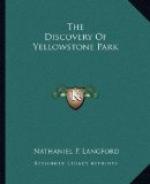Along the shore of the lake are several boiling springs situated in the top of incrusted craters, but which do not boil over, the sediment which has been deposited around them forming a wall or embankment, holding back the water.
But the most remarkable of all the springs at this point are six or seven of a character differing from any of the rest. The water in them is of a dark blue or ultra-marine hue, but it is wonderfully clear and transparent. Two of these springs are quite large; the remaining five are smaller, their diameters ranging from eight to fifteen feet. The water in one of these latter is thrown up to the height of two feet. The largest two of these springs are irregular in their general outline of nearly an oval shape, the larger of the two being about twenty-five feet wide by forty long, and the smaller about twenty by thirty feet. The discharge from each of them is about one gallon per minute. The sides of the springs are funnel-shaped, and converge until at the depth of thirty feet, the opening is about eight feet in diameter. From the surface or rim down to the lowest point of convergence where the opening enlarges, the sides of the funnel (which are corrugated and very uneven and irregular) are covered with a white deposit or incrustation which contrasts vividly with the dark opening at its base, which is distinctly visible at the depth of forty feet. These two springs are distant from each other about twenty yards, and there is a difference of about four feet in the elevation or level of the water. One peculiar feature of all these springs is that they seem to have no connection with each other beneath the surface. We find springs situated five or six feet apart, of the same general appearance but of different temperatures, and with the water upon different levels. The overflow from these springs for a great number of years has formed an incrusted bank overlooking the border of the lake, rising to the height of six feet; and, as the streams running from the springs are bordered with incrustations of various hues, depending upon the nature of the deposit or substance in solution, so the incrusted bank, which has been in process of formation for ages, exhibits all of these varied colors. In a number of places along the bank of the lake, this incrusted deposit is broken down and has crumbled into small pieces, upon which the waves have dashed until they have been moulded into many curious shapes, and having all the colors of the deposits in the springs—white, red and white blended, yellow and green. Cavernous hollows which fill the shore incrustation respond in weird and melancholy echoes to the dash of the billows.
The bottoms of the streams flowing from the deeper springs have for some distance a pure white incrustation; farther down the slope the deposit is white in the center with sides of red, and still farther down the white deposit is hidden entirely by the red combined with yellow. From nearly all these springs we obtained specimens of the adjoining incrustations, all of which were too hot to be held for more than a moment even with the gloved hand.




